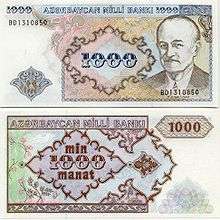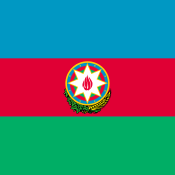Mammad Amin Rasulzadeh
| Mammad Amin Rasulzadeh | |
|---|---|
| Məmməd Əmin Rəsulzadə | |
|
Mammad Amin Rasulzadeh circa 1918 | |
| President of Azerbaijani National Council | |
|
In office 27 May 1918 – 7 December 1918 | |
| Personal details | |
| Born |
31 January 1884 Novxanı, Baku, Baku Governorate, Russian Empire |
| Died |
6 March 1955 (aged 71) Ankara, Turkey |
| Nationality | Azerbaijani |
| Political party | Musavat |
| Profession | The Leader of Azerbaijan |
| Religion | Islam |
| Signature |
|
Mammad Amin Rasulzadeh (Azerbaijani: Məhəmməd (Məmməd) Əmin Rəsulzadə /mæhæmˈmæd æˈmin ɾæsulzɑːˈdæ/, Turkish: Mehmet Emin Resulzade; 31 January 1884 – 6 March 1955) was an Azerbaijani statesman, scholar, public figure and the first and only president of the Democratic Republic of Azerbaijan (1918–1920). His expression "Bir kərə yüksələn bayraq, bir daha enməz!" ("The flag once raised will never fall!") became the motto of the independence movement in Azerbaijan in the 20th century.
Early life
Born at Novxanı, near Baku, Mammad Amin Rasulzadeh received his education at the Russian-Muslim Secondary School and then at the Technical College in Baku. In his years of study he created "Muslim Youth Organisation Musavat",[1] first secret organisation in Azerbaijan's contemporary history, and beginning from 1903 Rasulzade began writing articles in various opposition newspapers and magazines. At that time, his anti-monarchist platform and his demands for the national autonomy of Azerbaijan, aligned him with Social Democrats and future Communists. In 1904 he founded the first Muslim social-democrat organisation "Hummet" and became editor-in-chief of its newspapers, "Takamul"(1906–1907) and "Yoldash"(1907). Rasulzade also published many articles in non-partisan newspapers such as "Hayat", "Irshad" and also "Fuyuzat" journalOCLC 50542738. His dramatic play entitled "The Lights in the Darkness" was staged in Baku in 1908.
Rasulzade and his co-workers were representatives of the Azerbaijani intelligentsia. Most of them, including Rasulzade himself, had been members of the Baku organization of the Russian Social-Democratic Workers' Party (Bolsheviks) in 1905.[2] A photograph is extant in Soviet archives, showing Rasulzade with Prokopius Dzhaparidze and Meshadi Azizbekov, Bolsheviks who later became famous as two of the 26 Baku Commissars shot during the civil war.[3] During the First Russian Revolution (1905–1907), Rasulzade actively participated in revolutionary developments. As the story goes, it was Rasulzade who saved young Joseph Stalin in 1905 in Baku, when police were searching for the latter as an active instigator of riots.[4]
In 1909, under the persecution from Tsarist authorities, Rasulzade fled Baku to participate in the Iranian Constitutional Revolution of 1905-1911. While in Iran, Rasulzade edited Iran-e Azad newspaper,[5] became one of the founders of Democratic Party of Iran and began publishing its newspaper Iran-e Now[6] which means "New Iran" and which has been described as "the greatest, most important and best known of the Persian newspapers, and the first to appear in the large size usual in Europe".[7] In 1911, Rasulzade also published his book "Saadet-e bashar" ("Happiness of Mankind") in defense of the revolution.
After Russian troops entered Iran in 1911 and, in cooperation with British, assisted Qajar Court to put an end to Iranian Constitutional Revolution, Rasulzade fled to Istanbul, then capital of Ottoman Empire. Here, in the wake of Young Turk Revolution, Rasulzade founded a journal called Türk yurdu (The Land of Turks), in which he published his famous article "İran Türkleri" about the Iranian Turks.[8]
The Musavat Party and Azerbaijan Democratic Republic
.svg.png)
After the Amnesty Act of 1913, dedicated to the 300th anniversary of the Romanov dynasty, Rasulzade returned to Baku, left the Hummet party he was previously member of, and joined the then secret Musavat (Equality) party in 1913, established in 1911, which initially promoted pan-Islamist, pan-Turkist and Socialist ideas,[9][10][11][12][13] or more precisely Pan-Islamism yet with affinity for greater cultural bonds with the Turkic world,[14] and which eventually became Azerbaijani nationalist party, and quickly became its chief. In 1915 he started to publish party's newspaper "Açıq Söz" (Open word) which lasted till 1918. When February Revolution happened, Musavat together with other secret political parties in Russian Empire quickly legalized and became a leading party of Caucasian Muslims after it merged with Party of Turkic Federalists headed by Nasib Yusifbeyli. October revolution in 1917 lead to secession of Transcaucasia from Russia and Rasulzade became head of Muslim faction in the Seym, parliament of Transcaucasian Federation. After the dissolution of the Transcaucasian Federation Muslim faction re-organized into Azerbaijani National Council, whose head Rasulzade was unanimously elected in May 1918.
On May 28, 1918, the Azerbaijani National Council, headed by Rasulzade, declared an independent Azerbaijan Republic. Rasulzade also initiated the establishment of Baku State University together with Rashid Khan Gaplanov, minister of education with the funding of oil baron Haji Zeynalabdin Taghiyev in 1919. Rasulzade taught Ottoman literature at the University.
| “ | Bir kərə yüksələn bayraq, bir daha enməz!
The flag once raised will never fall! |
” |
| — Mammad Amin Rasulzade | ||
After the collapse of Azerbaijan Democratic Republic in April 1920, Rasulzade left Baku and went into hiding in the mountainous village of Lahij to direct the resistance to Sovietization, but in August 1920, after Soviet Russian army crushed the rebellions of Ganja, Karabakh, Zagatala and Lankaran, led by ex-officers of the Azerbaijani National Army, Rasulzade was arrested and brought to Baku. It was only due to his earlier rescue of Joseph Stalin in 1905, that Rasulzade was released and transferred from Azerbaijan to Russia. For the next two years, Rasulzade worked as the press representative at the Commissariat on Nations in Moscow. He was seconded to Saint Petersburg in 1922 from where he escaped to Finland.
Exile
For the rest of his life, Rasulzade lived in exile first in Turkey. However, the 1931 suppression of the emigre publications coincided with Rasulzade's expulsion from Turkey, and some saw it as the result of caving in to Soviet pressure. In exile Rasulzade published a pamphlet titled O Pantiurkizme v sviazi s kavkazskoi problemoi (О Пантюркизме в связи с кавказской проблемой, Pan-Turkism with regard to the caucasian problem), in which he firmly stated his view: Pan-Turkism was a cultural movement rather than a political program.[15] Thus, he went to Poland in 1938, where he met his wife, Vanda, niece of Polish statesman Józef Piłsudski,[16] then to Romania in 1940. During World War II he went to Berlin and met with Azeri POWs in attempt to encourage them to help Nazi Germany, although the mission proved unsuccessful.[17] Finally, after World War II, he went back to Ankara, Turkey in 1947, where he participated in the politics of the marginal Pan Turkic movement.[18] Due to sensitivity of his presence in either Turkey or Iran, and being often exiled, Rasulzade "cherished bad memories of both Iran and Turkey".[19] In his appeal to Azerbaijani people in 1953 through Voice of America, he stressed his hope that one day it will become independent again.[20] He died in 1955, a broken man according to Thomas Goltz,[18] and was buried in Cebeci Asri cemetery in Ankara.
Legacy and honors

Rasulzade was commemorated by many memorials throughout Azerbaijan, such as Baku State University, which was named after his honor. Rasulzade was depicted on the obverse of the Azerbaijani 1000 manat banknote of 1993-2006.[21]
Mehmet Emin Resulzade Anatolian High School, named after him, is a public high school at Ankara, Turkey.
Major works
Rasulzades works include:[1][22]
- The lights in a darkness. (play, 1908, not published)
- The critic of the party of Etidaliyyun. Teheran, 1910 (in Persian)
- The happiness of the mankind (Saadet-e basher). Ardebil, 1911 (in Persian)
- An unhappy life (Aci bir hayat). Baku, 1912
- Two views on the form of government (together with Akhmet Salikov). Moscow, 1917
- Role of Musavat in the formation of Azerbaijan. Baku, 1920
- Azerbaijan Republic: characteristics, formation and contemporary state. Istanbul, 1923
- Sayavush of our century. Istanbul, 1925
- Caucasian Turks. Istanbul, 1928
- Panturanism in regard with the Caucasian problem. Paris, 1930 (in Russian), reprinted with an English introduction in 1985 in Oxford
- About Azerbaijani Republic. Berlin, 1933 (in German)
- Azerbaijan problem. Berlin, 1938 (in German)
- Azerbaijan’s struggle for independence. Warsaw, 1939 (in Polish)
- Azerbaijan’s cultural traditions. Ankara, 1949
- Contemporary Azerbaijani literature. Ankara, 1950
- Contemporary Azerbaijani history. Ankara, 1951
- Great Azerbaijani poet Nizami. Ankara, 1951
- National Awareness. Ankara, 1978
- Nəsiman Yaqublu, "Məhəmməd Əmin Rəsulzadə ensiklopediyası" Kitab Klubu MMC, 2013, 506 səh.
References
- 1 2 "Memmed Amin Resûlzâde (Bakû/Novhanı, 31 Ocak 1884 - Ankara, 6 Mart 1955)" (PDF). Ministry of Culture and Tourism, Turkey. Archived from the original (PDF) on 2007-09-29. Retrieved 2007-04-02.
- ↑ Firuz Kazemzadeh (1951). The Struggle for Transcaucasia. New York Philosophical Library. p. 21. ISBN 0-8305-0076-6. OCLC 1943521.
- ↑ M.D. Guseinov. Тюркская Демократическая Партия Федералистов "Мусават" в прошлом и настоящем. Baku, 1927, p. 9
- ↑ Rais Rasulzade (his grandson), "Mammad Amin Rasulzade: Founding Father of the First Republic," in Azerbaijan International, Vol. 7:3 (Autumn 1999), pp. 22-23.
- ↑ Castagne, J. "Le Bolshevisme et l'Islam". Revue du Monde Mussulman. Paris. 51 (1): 245–246.
- ↑ Rasulzade, Mammed Amin (1992). Works, Volume I. Baku.
Rasulzade’s letter to Tereqqi newspaper’s 16 August 1909 issue
- ↑ Iran-e Now. Encyclopædia Iranica.
- ↑ Azerbaijan Democratic Republic. Azerbaijan Government 1918-1920. Baku, "Youth", 1990. page 25 lines 3-11 from above
- ↑ Pan-Turkism: From Irrendentism to Cooperation by Jacob M. Landau P.55
- ↑ On the Religious Frontier: Tsarist Russia and Islam in the Caucasus by Firouzeh Mostashari P. 144
- ↑ Ethnic Nationalism and the Fall of Empires by Aviel Roshwald, page 100
- ↑ Disaster and Development: The politics of Humanitarian Aid by Neil Middleton and Phil O'keefe P. 132
- ↑ The Armenian-Azerbaijan Conflict: Causes and Implications by Michael P. Croissant P. 14
- ↑ Prof. Tadeusz Swietochowski, Russian and Azerbaijan: A Borderland in Transition, Columbia University Press, 1995, p. 52.
- ↑ Swietochowski, Tadeusz (1995). Russian and Azerbaijan: A Borderland in Transition. Columbia University Press. p. 130. ISBN 0-231-07068-3.
- ↑ Rais Rasulzade, grandson. "Mammad Amin Rasulzade, Founding Father of the First Republic". Azerbaijan International. ISSN 1075-086X.
- ↑ Swietochowski, Tadeusz(1995) Russia and Azerbaijan: A Borderland in Transition, Columbia University, p. 133
- 1 2 Goltz, Thomas (1998). Azerbaijan diary : a rogue reporter's adventures in an oil-rich, war-torn, post-Soviet republic. M.E. Sharpe. p. 18. ISBN 0-7656-0243-1.
- ↑ Charles van der Leeuw, Azerbaijan: A Quest for Identity, Palgrave Macmillan, 2000, p. 121.
- ↑ http://www.rasulzade.org/ME_Rasulzade_nin_Amerikanin_Sesinde_chixishi.mp3
- ↑ National Bank of Azerbaijan. National currency: 1000 manat. – Retrieved on 24 March 2009.
- ↑ "Məhəmməd Əmin Rəsulzadə (1884 Bakı - 1955 Ankara)". Retrieved 2007-04-02.
External links
- Leader's Page
- Mammad Amin Rasualzade Website
- Speech by Rasulzadeh
- "Mammad Amin Rasulzade, Founding Father of the First Republic," by grandson Rais Rasulzade, Azerbaijan International, Vol. 7:3 (Autumn 1999), pp. 22–23.
- "Mammad Amin Rasulzade, Statesman, Democratic Republic of Azerbaijan Leaders" (1918-1920), in Azerbaijan International, Vol 6:1 (Spring 1998), pp. 26–30.

